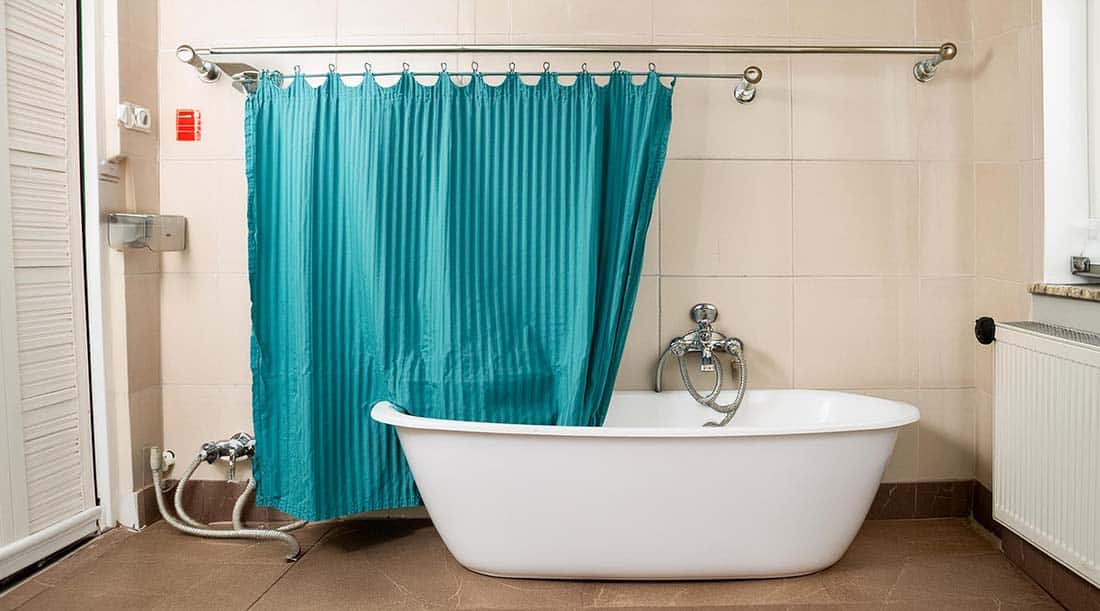Choosing the correct placement for your shower curtain isn’t just a matter of preference; it’s essential for maintaining a dry and safe bathroom environment. A properly positioned shower curtain acts as a barrier, ensuring that water remains within the confines of your tub or shower area.
This simple yet effective solution significantly reduces the risk of water damage and slip hazards, keeping your bathroom tidy and accident-free. With the right setup, you can enjoy a worry-free shower experience, knowing that your bathroom floor will stay dry and clean.
Top Shower Curtains in 2024
- Rank #1 – Barossa Design Plastic Shower Liner Clear – Premium PEVA Shower Curtain
- Rank #2 – BigFoot Shower Curtain Liner Heavy Duty Shower Curtain
- Rank #3 – Dynamene Sage Green Shower Curtain
[toc]
Types of Shower Curtains
Many people wonder if their shower curtain should hang inside or outside the tub. This question is not just about keeping water off the floor. It’s also about the type of shower curtain you use.
There are different types, such as fabric, vinyl, and PEVA. Each type has its benefits. Let’s explore these different shower curtains and find out how they should be hung to keep your bathroom dry and stylish.
Fabric Shower Curtains
Fabric shower curtains come in many colours and designs. They make your bathroom look pretty. But, they need a liner to keep water in the tub. Here are some points about fabric curtains:
- Fabric curtains are soft and can be washed in a machine.
- They need a liner to stop water from getting out.
- These curtains can be eco-friendly and made from materials like cotton or hemp.
People like fabric curtains because they can easily change the look of their bathrooms. But remember to keep the liner inside the tub to catch water.
Vinyl Shower Curtains
Vinyl shower curtains are popular because they are cheap and block water well. Here’s more about them:
- Vinyl curtains are waterproof, so they don’t need a liner.
- You can clean them with a damp cloth, which is easy.
- They come in many colours and patterns, just like fabric curtains.
For vinyl curtains, you can hang the bottom part inside the tub. This way, water won’t spill onto the floor. People like these curtains because they are simple to take care of.
Peva Shower Curtains
PEVA shower curtains are a good choice if you want something without harmful chemicals. Here are some points about PEVA curtains:
- PEVA curtains are made without chlorine, which is good for health.
- They are waterproof and don’t need a liner.
- This type of curtain is soft and can be recycled, which is good for the Earth.
PEVA curtains should also hang inside the tub to keep water away from the floor. They are a great choice for people who care about health and the planet.
Factors to Consider When Picking a Shower Curtain
Many people wonder about the correct placement of a shower curtain. It’s not just a style choice. Different factors affect where you should hang your curtain. These include the design of your bathroom, where your showerhead is, the water pressure, and the length of the curtain itself.
Bathroom Layout
The size and shape of your bathroom play a big role. Small bathrooms might need the curtain inside to save space, while larger bathrooms allow more flexibility. You should also consider the floor material. Tiles can get slippery when wet, and a curtain outside the tub can cause water to spill and create a hazard.
- Space-saving: Inside placement for compact bathrooms.
- Safety first: Prevent slippery floors with inside placement.
Showerhead Position
The location of your showerhead affects curtain placement. A showerhead facing away from the curtain might allow it to be outside. But a showerhead facing the curtain needs it inside. This prevents water from spraying out. Make sure the curtain is close to the showerhead for the best protection.
- Away-facing: The curtain can be outside.
- Towards-facing: The curtain should likely be inside.
Water Pressure
High water pressure can push your curtain out of the tub. This can cause water to leak onto the floor. Lower pressure might not cause this problem. Always test your shower’s pressure. You might need a heavier curtain or weights at the bottom to keep it in place.
- High pressure: Consider a weighted curtain inside the tub.
- Low pressure: Less risk of water escaping.
Shower Curtain Length
The curtain should reach the tub’s inside but not drag on the floor. Too long and it becomes a tripping hazard. Too short and water escapes. Measure from the curtain rod to just above the tub floor. This ensures the curtain does its job without being a safety risk.
| Curtain Length | Effectiveness |
|---|---|
| Just right | Prevents water spillage, no tripping. |
| Too long | Possible tripping hazard. |
| Too short | Allows water to escape. |
Shower Curtain Rods
Many people wonder about the right place for a shower curtain. It can hang inside or outside the tub. The shower curtain’s position depends on the type of rod and curtain you use. A proper setup keeps water off the bathroom floor. Let’s discuss different rods and their setups.
Tension Rods
Tension rods are popular for hanging shower curtains. They are easy to install and do not need screws. Place them between two walls. The rod expands and holds tight by the tension. This type of rod is great for renters or people who like to change their bathroom often. Here are more details:
- No tools are needed for the installation
- Adjustable to fit different spaces
- It can be moved and reused in different locations.
Permanent Rods
Permanent rods are fixed to the wall with screws. They are sturdy and can hold heavier curtains. These rods do not move once installed. You need a drill and screws to put them up. Here are some points to consider:
- Sturdy and secure for long-term use
- Great for heavy or decorative curtains
- Installation requires some DIY skills.
Advantages and Drawbacks of Putting Shower Curtain Inside or Outside Tub
Deciding whether to place a shower curtain inside or outside the tub can be puzzling. This choice affects both the bathroom’s cleanliness and the user’s safety. Let’s explore the advantages and disadvantages of each option to help you make an informed decision.
Inside the Tub
Placing a shower curtain inside the tub is common. Let’s delve into why people favour this method:
- Easy to manage: Tucking the curtain inside is simpler, ensuring full coverage of the tub’s edges.
- Mildew resistance: Shower curtains inside the tub dry quicker, reducing mildew growth.
Yet, this practice has its downsides. A curtain inside can stick to your skin, which feels unpleasant. It can also hide the tub’s design, taking away from the bathroom’s overall look.
Outside the Tub
Some opt to hang their shower curtain outside the tub. Here are the reasons:
- Showcases the tub: This way, the tub’s design remains visible, enhancing the bathroom’s appearance.
- No clingy curtain: With more space, the curtain won’t stick to you as you shower.
- Decorative appeal: Curtains outside make a stylish statement, acting as a focal point in the decor.
On the other hand, water can escape onto the floor, creating a slippery surface. This poses a risk for slips and falls. If not cleaned up quickly, it might lead to water damage or mould.
Maintenance and Cleaning
Many people wonder where the right place for a shower curtain is. The answer impacts cleanliness and safety. Keeping it inside or outside the tub matters. It affects how you maintain and clean your bathroom space.
Mold and Mildew Prevention
Keeping your bathroom free from mould and mildew is crucial. Place the curtain inside the tub while showering. This prevents water from spilling out and helps keep the floor dry. A dry floor means less chance for mould to grow. After showering, spread the curtain out. This lets it dry quickly and stops mould from forming.
- Use a ventilation fan during and after showers.
- Wipe excess moisture from surfaces with a towel.
- Consider a curtain with antimicrobial properties.
Regularly washing your curtain is also key. A clean curtain is less likely to have mould.
Cleaning Tips
Cleaning your shower curtain is straightforward. This should be done once a month. You can wash plastic or vinyl curtains in the machine. Use warm water and a gentle detergent. Add a couple of towels to help scrub the curtain. For fabric curtains, check the label for care instructions.
| Material | Washing Machine | Hand Washing |
|---|---|---|
| Plastic/Vinyl | Yes, with towels | Warm soapy water |
| Fabric | Check label | Mild detergent |
Always let the curtain dry entirely before rehanging it. This will keep it fresh and clean for longer.
FAQs
What Materials Are Commonly Used for Shower Curtains?
Shower curtains are typically made from various materials, including vinyl, polyester, and cotton. Vinyl is waterproof and easy to clean, making it a popular choice for many households. Polyester offers a more fabric-like feel and is often treated with water-resistant coatings. Cotton shower curtains, while more absorbent, usually require a liner to prevent water from soaking through.
How Do I Maintain and Clean My Shower Curtain?
Maintaining a shower curtain involves regular cleaning to prevent mold and mildew buildup. Vinyl and polyester curtains can be wiped down with a damp cloth and mild detergent. Many fabric shower curtains are machine washable; however, checking the care label for specific instructions is advisable. It is also beneficial to air-dry the curtain to maintain its integrity and appearance.
Can I Use a Shower Curtain Without a Liner?
While it is possible to use a shower curtain without a liner, it is generally not recommended, especially for fabric curtains. A liner helps to protect the curtain from water damage and mold growth. If you use a curtain without a liner, ensure it is made from a water-resistant material and regularly cleaned to prevent any potential issues.
What Sizes Do Shower Curtains Come in?
Shower curtains come in various sizes to accommodate different shower spaces. The most common dimensions are 72 inches by 72 inches, which fits standard shower stalls. However, options are also available in more comprehensive and longer sizes, such as 54 inches by 78 inches or 108 inches by 72 inches, to suit specific needs. Measuring your shower area before purchasing is advisable to ensure the correct fit.
Are There Any Design Options for Shower Curtains?
Yes, shower curtains come in various designs, colors, and patterns to suit multiple aesthetic preferences and bathroom themes. From solid colors to intricate prints and textures, one can find shower curtains that match or complement their decor. Many retailers also offer customizable options, allowing individuals to select their preferred design or print personal images on the curtain.
Wrapping up
Deciding on the placement of your shower curtain is simple. Keep it inside the tub to prevent water spillage and maintain bathroom safety. An elegant, tidy look is achieved outside the tub, though it’s less common. Remember, the choice reflects personal preference and practicality for a serene bath time experience.

